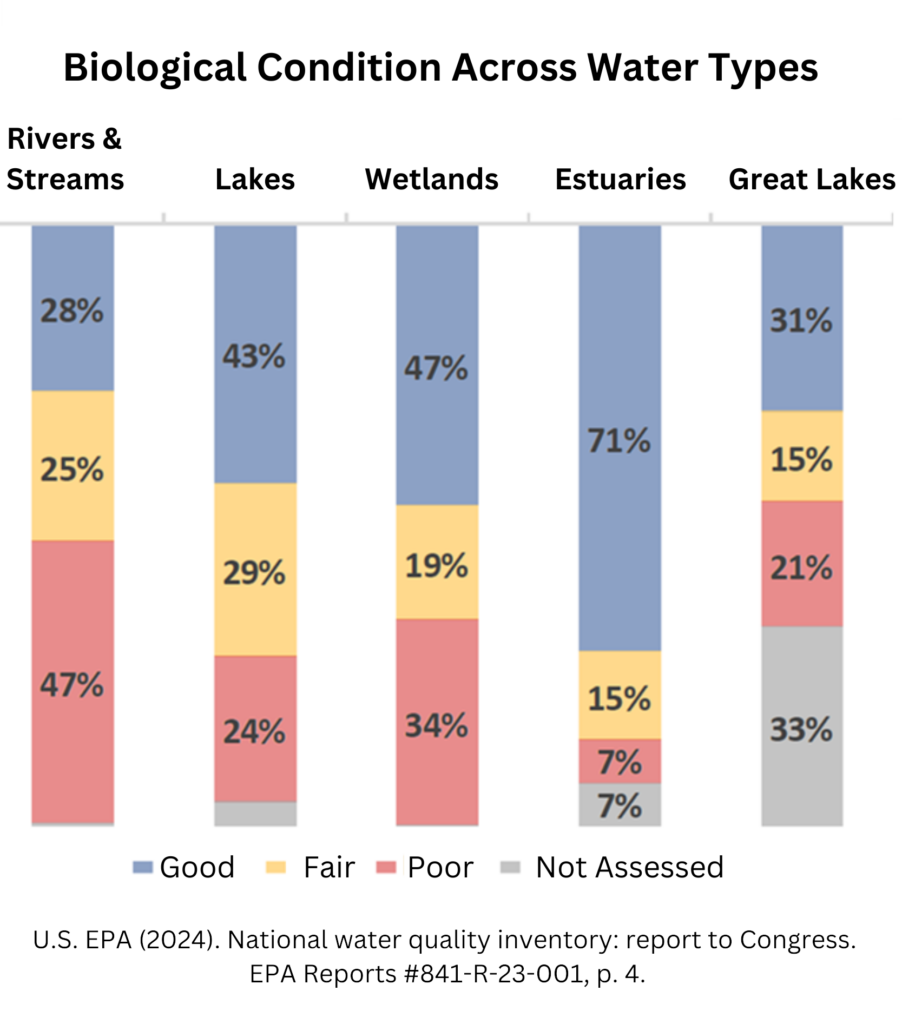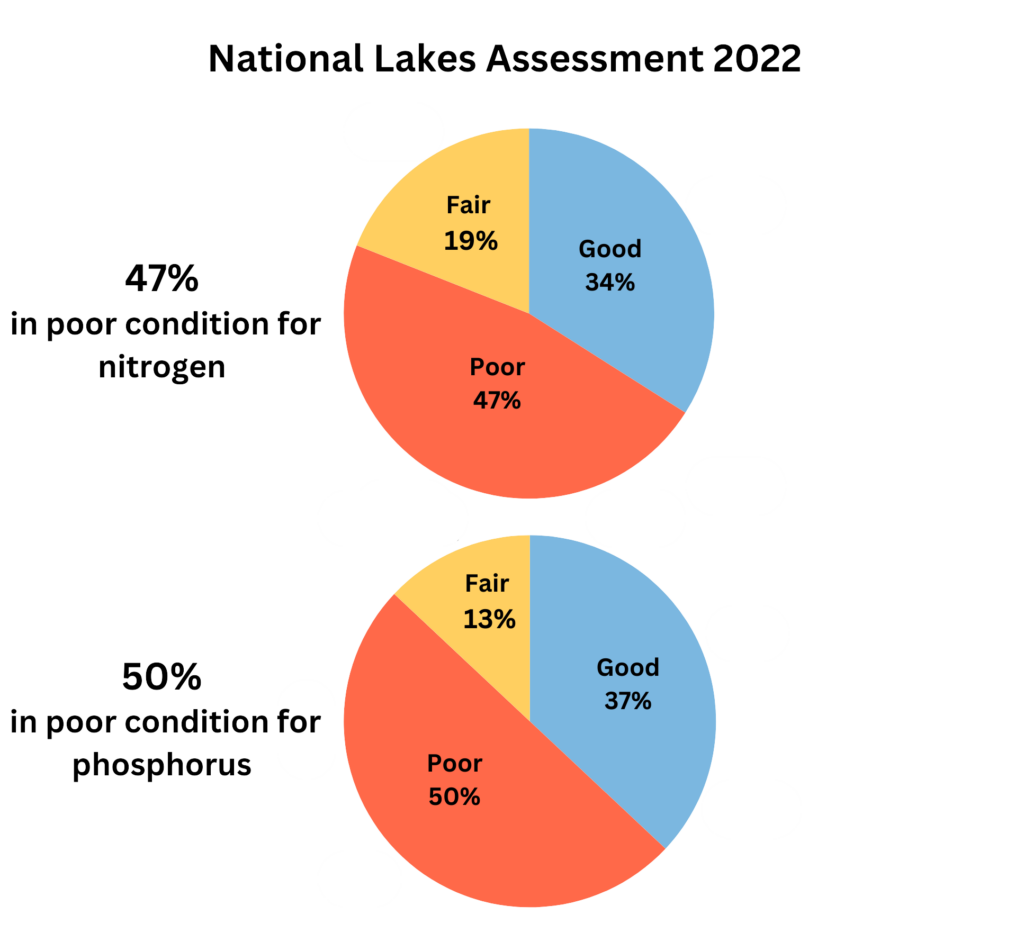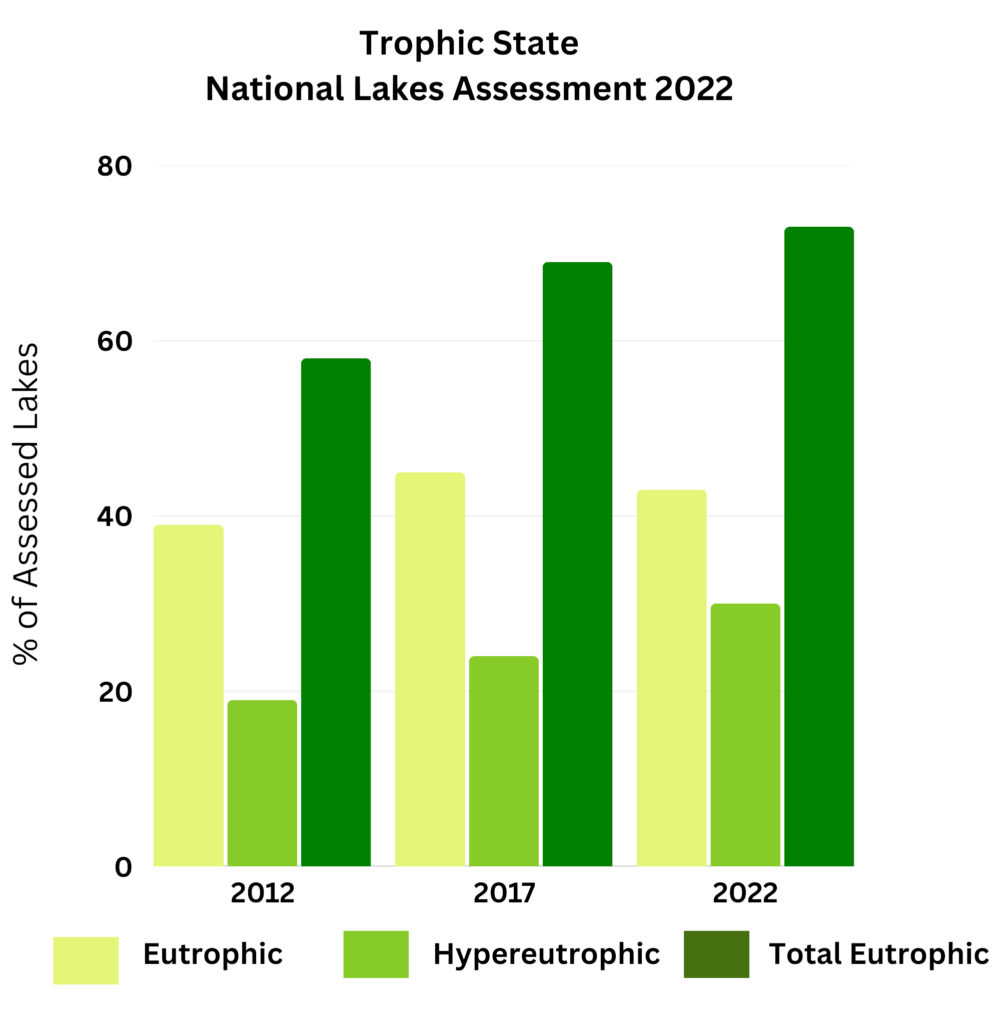The EPA generates reports approximately every five years, separately assessing each of 4 categories of waterways. Known as the National Aquatic Resource Surveys (NARS), they cover:
Lakes – published 2024 covering 2022.[1]
Wetlands – published 2024 covering 2021.[2]
Rivers & Streams – published 2023 covering 2018-2019.[3]
Coastal Zones including Estuaries and Great Lakes “near-shore” areas – published 2021 covering 2015.[4]
Additionally, every five years the EPA publishes the National Water Quality Inventory: Report to Congress which integrates the most recent reports. The latest report to Congress was published in October 2024.[5]
U.S. EPA (2024) National Lakes Assessment: The fourth collaborative survey of lakes in the United States. EPA 841-R-24-006. https://nationallakesassessment.epa.gov/webreport (Accessed 2/18/25)
U.S. EPA (2024) National Wetland Condition Assessment: The third collaborative survey of wetlands in the United States. EPA 843-R-24-001. https://wetlandassessment.epa.gov/webreport (Accessed 3/2/25)
U.S. EPA (2023) National Rivers and Streams Assessment: The Third Collaborative Survey. EPA 841-R-22-004. https://riverstreamassessment.epa.gov/webreport (Accessed 3/2/25)
U.S. EPA (2021) National Coastal Condition Assessment: A Collaborative Survey of the Nation’s Estuaries and Great Lakes Nearshore Waters, EPA 841-R-21-001
https://www.epa.gov/national-aquatic-resource-surveys/national-coastal-condition-assessment-2015-results (Accessed 3/2/25)EPA (2024). National Water Quality Inventory: Report to Congress. EPA 841-R-23-001.
Few generalizations pertain to all 4 studied waterway categories.
Within water categories, the EPA uses many different “indicators” – evaluations of a specific metric regarding water quality. Rivers and streams, for example, are graded for 16 indicators.[1]
There is no single assessment that aggregates all indicators.
The EPA tends to downplay long-term comparisons of data.
The reports say very little about the causes of poor conditions.[2]
For these reasons, journalists and researchers looking for “overview” statements from government reports or websites may not find much. We surmise that due to the long-term inability to address the failing health grades for U.S. waterways, government agencies are hesitant to provide quotes that highlight those shortcomings.[3]
U.S. EPA (2023) National Rivers and Streams Assessment: The Third Collaborative Survey. EPA 841-R-22-004. [“EPA used 16 indicators to assess the biological, chemical, and physical condition of rivers and streams, as well as characteristics that pose risks to human health.”]
U.S. EPA (2024) National Lakes Assessment: The Fourth Collaborative Survey of Lakes in the United States. EPA 841-R-24-006. [“While this report explores associations between stressors and biological indicators of condition, additional research is needed to explain the causes of degraded conditions or to identify sources of stressors.”]
Because states are required to assess waterways as “impaired” or not, some reports have aggregated state results to then be able to offer an overview of the total share of impaired waterways. However, states have widely varying assessment tools and characterizations that do not generally support a nationwide assessment. See, EPA (2024). National Water Quality Inventory: Report to Congress. [“While the state water quality reports were, and continue to be, valuable for the individual states, numerous independent and internal reviews found the differences in methods across states prevented valid national level reporting.”]
We propose the following:
Less than half of U.S. freshwater bodies have healthy biological communities i.e., are in good biological condition. This includes rivers, streams, and lakes, including Great Lakes near-shore waters.[1-4]
Less than one-third of river and stream miles have healthy biological communities.[5]

Biological condition is the “presence, number, and diversity” of life, including fish, invertebrates, and other organisms.[6,7]
The EPA states that “Biological condition is the most comprehensive indicator of water body health: when the biology of a stream is healthy, the chemical and physical components of the stream are also typically in good condition.”[8] For wetlands, “Vegetation is a particularly good indicator of wetland condition…”[9] The chart shown here assessing biological condition across water types is the single chart presented in the executive summary of the 2024 Report to Congress.[10]
EPA (2024). National Water Quality Inventory: Report to Congress. EPA 841-R-16-011, p. 4.
Note: The lakes estimate in the chart has been superseded by the 2024 National Lakes Assessment, which found that biological condition was “good” for 42% of lakes. “Poor” condition had risen to 29%.
See, U.S. EPA (2024) National Lakes Assessment: The fourth collaborative survey of lakes in the United States. EPA 841-R-24-006.Note: The wetlands estimate in the chart has been superseded by the 2024 National Wetlands Condition Assessment, which found that “45% of wetland area was in good condition.” See, U.S. EPA (2024) National Wetland Condition Assessment: The third collaborative survey of wetlands in the United States. EPA 843-R-24-001.
U.S. EPA (2021) National Coastal Condition Assessment: A Collaborative Survey of the Nation’s Estuaries and Great Lakes Nearshore Waters, EPA 841-R-21-001, p. 16. [31% good condition / 67% assessed = ~46% of assessed areas are in good condition]
U.S. EPA (2023) National Rivers and Streams Assessment 2018 – 2019 Key Findings. [“Less than one-third of our river and stream miles (28%) had healthy biological communities…” Note that rivers and streams are assessed by miles rather than rating entire rivers and streams.]
U.S. EPA (2023) National Rivers and Streams Assessment: The Third Collaborative Survey. EPA 841-R-22-004. [“The biology of a water body (the biological condition) can be characterized by the presence, number, and diversity of macroinvertebrates, fish, and other organisms.”]
U.S. EPA (2021) National Coastal Condition Assessment, p. 16. [“Good sites (for biological condition) have a wide variety of species, more diversity, and fewer pollution-tolerant species than fair or poor sites.”]
U.S. EPA (2017) National Water Quality Inventory: Report to Congress, p. 6.
U.S. EPA (2024) National Wetland Condition Assessment.
U.S. EPA (2024). National Water Quality Inventory, p. 4.
Nutrient pollution is a cause of water problems, while biological condition is a result. Biological condition is strongly influenced by nutrient pollution.[1,2] Poor biological condition is almost twice as likely in river and stream miles rated poor for nutrients.[3] Wetlands are “1.6 and 1.7 times more likely, respectively, to be rated poor or very poor” when nutrient levels are elevated.[4]
Furthermore, nutrient pollution is almost certainly the primary driver of poor water quality in the U.S. Most federal agencies are unwilling to state that, probably due to their decades’ long inability to address the problem. However, on rare occasions they have stated the obvious.[5,6]
The EPA regularly notes that nutrient pollution is “the most widespread stressor” in water bodies.[7-9]
U.S. EPA (2023) National Rivers and Streams Assessment: The Third Collaborative Survey. EPA 841-R-22-004. [“Poor biological condition was more likely when rivers and streams were in poor condition for nutrients.”]
U.S. EPA (2024) National Lakes Assessment: The Fourth Collaborative Survey of Lakes in the United States. EPA 841-R-24-006. [“Poor biological condition was more likely when lakes were in poor condition with respect to nutrients.”]
U.S. EPA (2020) National Rivers and Streams Assessment 2013–2014: A Collaborative Survey. EPA 841-R-19-001. pp. 28-29 https://www.epa.gov/national-aquatic-resource-surveys/nrsa [“… a finding of poor biological condition based on benthic macroinvertebrates was almost twice as likely in rivers and stream miles rated poor for Nutrients.” p. 8]
U.S. EPA (2024) National Wetland Condition Assessment: The Third Collaborative Survey of Wetlands in the United States. EPA 843-R-24-001. [“In wetlands where phosphorus and nitrogen were elevated, biological condition expressed by the nonnative plant indicator was 1.6 and 1.7 times more likely, respectively, to be rated poor or very poor.]
U.S. EPA (2015) A Compilation of Cost Data Associated with the Impacts and Control of Nutrient Pollution, EPA 820-F-15-096, p. I.1. [“The finding that nutrient pollution is the leading cause of use impairment in U.S. waters is supported by data from states’ water quality assessment reports, National Aquatic Resources Surveys, and associated reports to Congress…”]
U.S. EPA (2017) National Water Quality Inventory: Report to Congress, EPA 841-R-16-011, p. 5 [“High nutrient levels are the leading problem in the nation’s lakes.” p.10]
U.S. EPA (2024) National Lakes Assessment. [“Nutrient pollution was the most widespread stressor measured.”]
U.S. EPA (2023) National Rivers and Streams Assessment. [“Nutrients (phosphorus and nitrogen) were the most widespread stressors.”]
U.S. EPA (2021) National Coastal Condition Assessment: A Collaborative Survey of the Nation’s Estuaries and Great Lakes Nearshore Waters, EPA 841-R-21-001, p. 53. [For Great Lakes near-shore areas, “Similar to findings from other assessments, the NCCA found that elevated nutrient levels are widespread stressors.”]
Nutrient Pollution in Lakes – About half of the nation’s lakes are rated poor for nitrogen and phosphorus levels.
In the 2024 EPA National Lakes Assessment, nutrient pollution is the most widespread stressor measured.
For nitrogen, 47% of lakes are rated in poor condition.
For phosphorus, 50% of lakes are rated in poor condition.[1]

The share of lakes rated poor for nutrient levels has increased from 2012 through 2022.[2]

U.S. EPA (2024) National Lakes Assessment: The Fourth Collaborative Survey of Lakes in the United States, EPA 841-R-24-006. Chemical Indicators/Nutrients, Exhibits 22 & 23.
U.S. EPA (2024) National Lakes Assessment, Chemical Indicators/Nutrients, Exhibits 24 and 25. [2012: Poor for N 41%, Poor for P 44%; 2017: Poor for N 46%, Poor for P 45%; 2022: Poor for N 47%, Poor for P 50%]
Eutrophication in Lakes – Almost three-quarters of the nation’s lakes are eutrophic, with almost a third hypereutrophic.
Reported in the 2024 EPA National Lakes Assessment:
43% of lakes are rated as eutrophic.
30% of lakes are rated as hypereutrophic.
In total, 73% of lakes are eutrophied.[1]
The report defines eutrophic as having “high nutrient levels and high biological productivity” and hypereutrophic as having “extreme primary production (high levels of photosynthesis), reduced biological diversity, and reduced metabolism, which results in an imbalanced lake ecosystem.”

The EPA asserts that “no statistically significant changes occurred from 2017 to 2022.” However, the changes from 2012 to 2022 are clearly significant and point to steadily worsening levels of nutrient pollution in lakes.
U.S. EPA (2024) National Lakes Assessment: The Fourth Collaborative Survey of Lakes in the United States, EPA 841-R-24-006. Trophic State Indicator, Exhibits 8 and 9.
Rivers and Streams – More than 40% of the nation’s rivers and streams are rated poor for nitrogen and phosphorus levels.
The 2023 EPA National Rivers and Streams Assessment reports: 44% of river and stream miles are rated poor for elevated nitrogen
42% of miles are rated poor for elevated phosphorus.[1]

The share of river and stream miles rated poor for nutrient levels over time:[2]

U.S. EPA (2023) National Rivers and Streams Assessment: The Third Collaborative Survey. EPA 841-R-22-004, Exhibits 10 and 11.
U.S. EPA (2023) National Rivers and Streams Assessment, Exhibits 12 and 13. [2009: Poor for N 44%, Poor for P 51%; 2014: Poor for N 44%, Poor for P 60%; 2019: Poor for N 44%, Poor for P 42%]
Wetlands – The EPA’s 2024 National Wetland Condition Assessment reports:
For nitrogen, 28% of assessed wetlands are rated as poor.
For phosphorus, 40% of assessed wetlands are rated poor.[1]
Physical alterations are the largest cause of wetland degradation, even larger than nutrient pollution.[2] The largest cause of physical alterations is agricultural expansion, both historically and currently.[3-6]
U.S. EPA (2024) National Wetland Condition Assessment: The Third Collaborative Survey of Wetlands in the United States. EPA 843-R-24-001, Exhibit 21 [Large shares of total wetlands are not assessed due to lack of surface water, making nutrient assessments and year-to-year comparisons somewhat less meaningful. The percentages noted here are calculated as a share of assessed acres.]
U.S. EPA (2024) National Wetland Condition Assessment. [43% of assessed acres are rated poor due to “physical alterations.”]
Dahl, T. E. & Allord, G. J. (1997). History of wetlands in the conterminous United States, US Geological Survey, pp. 19-26. [From the 1950’s through the 1970’s, “Agriculture was responsible for more than 80 percent of these (wetlands) losses.” In the 1600’s there were about 220 million acres of wetlands, while currently there is about half that amount 116 million acres — according to Lang et al., see, p. 8]
Lang, M.W., et al., (2024). Status and Trends of Wetlands in the Conterminous United States 2009 to 2019. U.S. Department of the Interior; Fish and Wildlife Service, Figure 4, p. 18. [The largest driver of wetland conversion is noted as “upland agriculture.” Probably due to an unwillingness to highlight agriculture as the primary driver, there is no clear explanation of what this term means. As we understand it, this refers to the draining and filling of wetlands to create higher and drier land suitable for agriculture.]
Craig Cox & Soren Rundquist (2013) Going, going, gone! Millions of Acres of Wetlands and Fragile Land Go Under the Plow, Environmental Working Group, p. 5. [“Corn and soybeans were planted on 60 percent (612,000 acres) of the wetland and wetland buffer acres appropriated for row crop production in hotspot counties.”]
Zedler, J. B. (2003). Wetlands at Your Service: Reducing Impacts of Agriculture at the Watershed Scale. Frontiers in Ecology and the Environment, 1(2), 65–72, p. 65. [“Farming has transformed the landscape of the US Midwest by converting upland and wetland habitats to crops and pastures, simultaneously changing hydrologic conditions and water quality, and threatening the region’s biodiversity.”]
As required by the Clean Water Act, each state must develop lists of “impaired waters” and file the information with the EPA.[1] The EPA reports that data but does not aggregate it to provide national figures.
The EPA leaves it to state agencies to monitor and assess their waters and set their own water quality standards. These methods vary from state to state, along with the frequency of data collection, making it difficult to use the information for “national level reporting.”[2] The purpose of these state assessments is to identify local problems and help prioritize local solutions.
Despite these inherent complexities, some organizations, most notably the non-profit Environmental Integrity Project (EIP), have analyzed and aggregated state data to provide percentages of waterways “classified as impaired for one or more designated uses.”[3] More information is provided below about EIP’s aggregated state data.
EPA (2024). National Water Quality Inventory: Report to Congress, pp.24-25. [In the Clean Water Act, “Section 305(b) calls for states to submit a “description of the water quality of all navigable waters; the extent to which all navigable waters of such State provide for the protection and propagation of a balanced population of shellfish, fish, and wildlife, and allow recreational activities in and on the water.” p. 7]
EPA (2024). National Water Quality Inventory, p. 7. [“While the state water quality reports were, and continue to be, valuable for the individual states, numerous independent and internal reviews found the differences in methods across states prevented valid national level reporting.”]
The Clean Water Act at 50: Promises Half Kept at the Half-Century Mark. (2022) Environmental Integrity Project (EIP), pp. 16-17. https://environmentalintegrity.org/wp-content/uploads/2022/03/Revised-CWA-report-3.29.22.pdf
Lakes – Recent state assessments analyzed by the Environmental Integrity Project (EIP), based on Integrated Water Reports filed with the EPA, found that nationally an average of 55% of lakes, ponds, and reservoirs were “impaired.”[1]
Rivers and Streams – EIP found an average of 51% of total assessed miles of rivers and streams were impaired.[1]
Environmental Integrity Project (EIP) (2022) The Clean Water Act at 50: Promises Half Kept at the Half-Century Mark. Table 1. [Data from the EIP’s state assessments were taken from biennial reports published between 2016-2020. See, pp. 16-17]
The EPA defines an impaired waterway as one that is “unable to support one or more of the water quality standards” that the state itself has set. These standards are broadly understood to include: Swimming.
Eating fish.
Aquatic life.
Drinking water.[1]
Under the Clean Water Act, states must develop TMDLs (Total Maximum Daily Loads) for all the waters they have identified as impaired. A “TMDL is the calculation of the maximum amount of a pollutant allowed to enter a waterbody so that the waterbody will meet and continue to meet water quality standards for that particular pollutant.”[2]
U.S. EPA (2024) National Water Quality Inventory: Report to Congress, 841-R-16-011, pp. 25-26.
U.S. EPA (2022) Overview of Total Maximum Daily Loads (TMDLs). https://www.epa.gov/tmdl/overview-total-maximum-daily-loads-tmdls [“According to the Clean Water Act, each state must develop TMDLs for all the waters identified on their Section 303(d) list of impaired waters, according to their priority ranking on that list.”]
